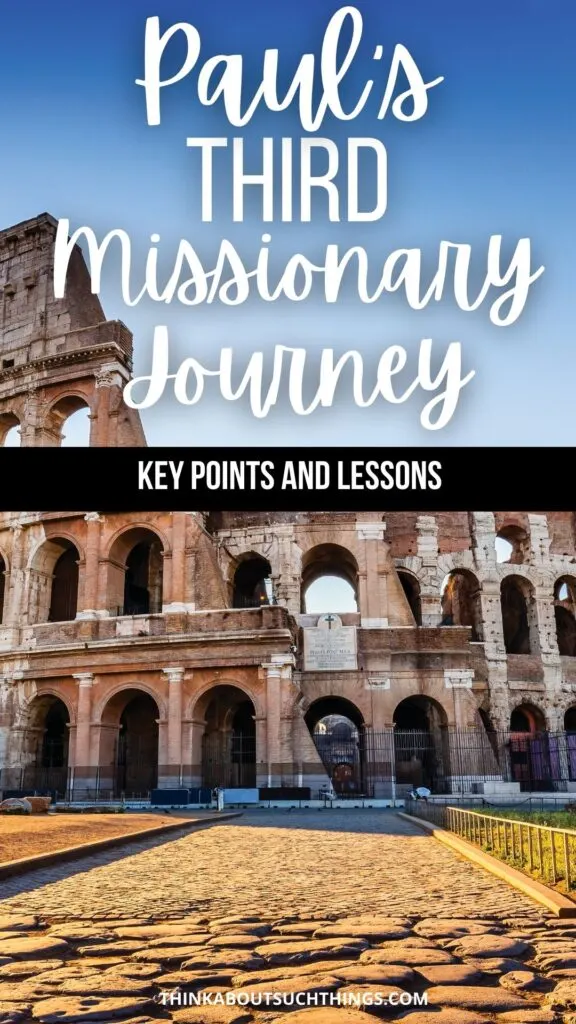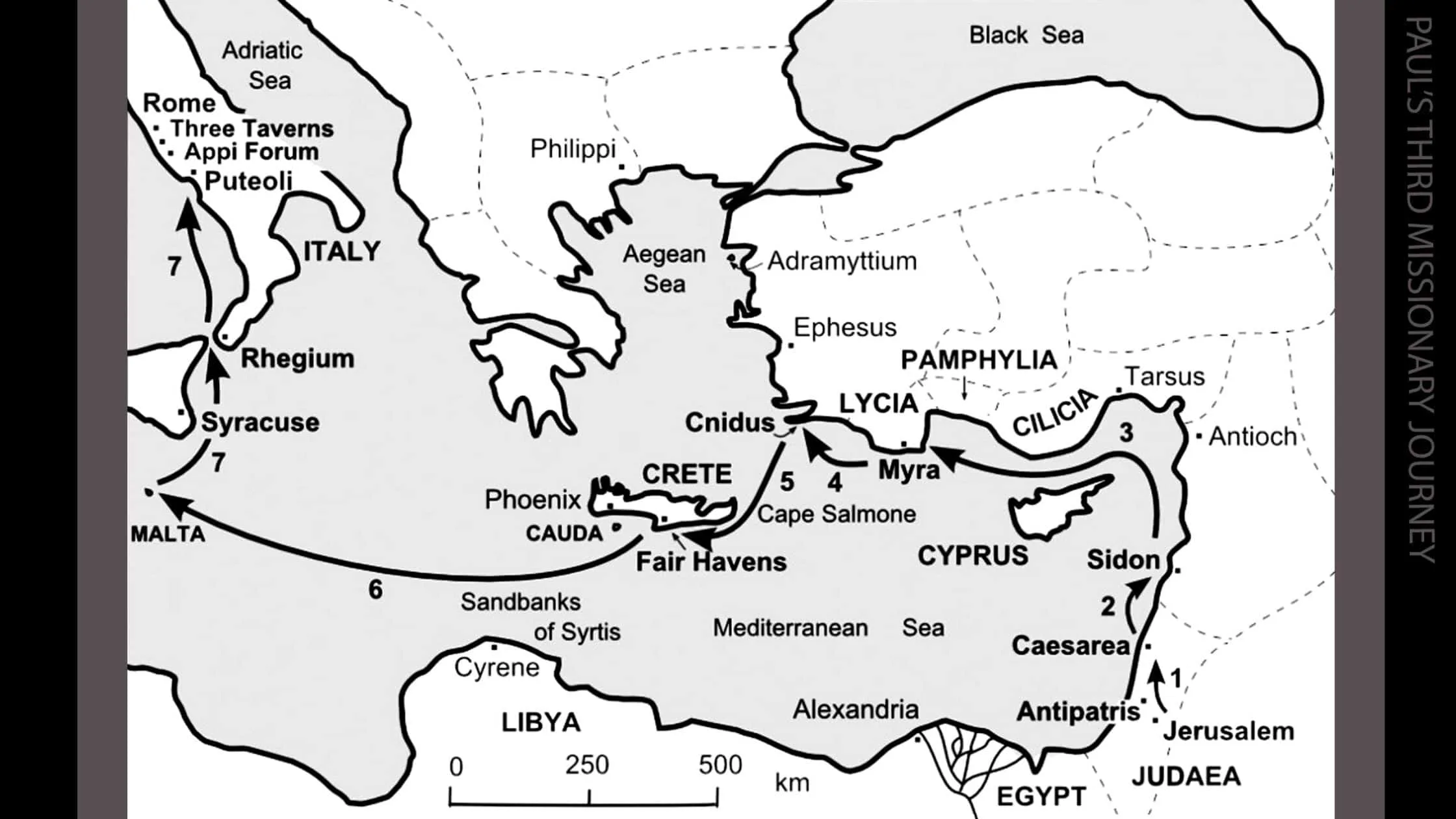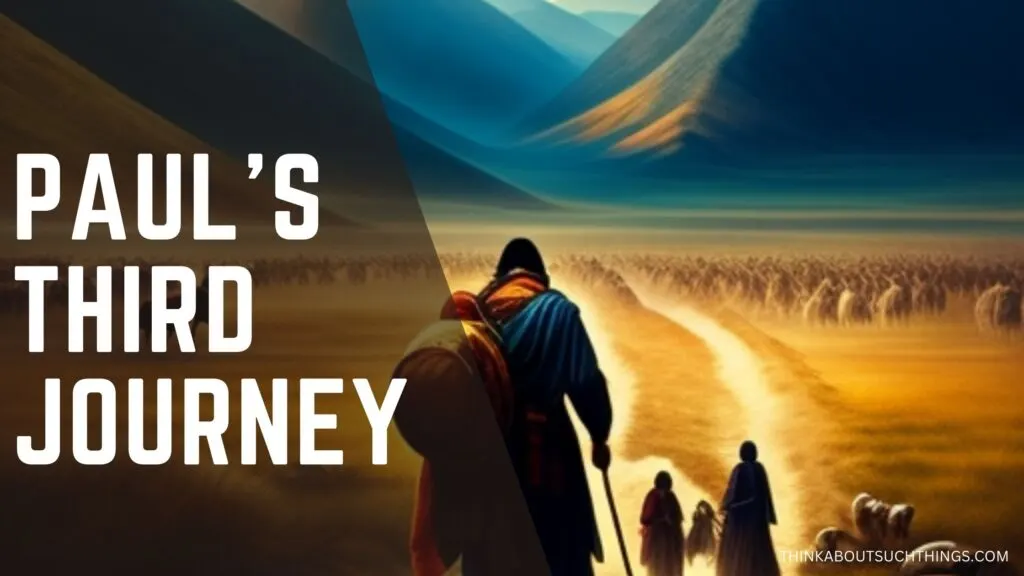In this article, we will explore Paul’s third missionary journey looking at key points, locations, lessons we can learn, and a map of his journey.
The book of Acts in the Bible tells of the apostle Paul and his missionary work. Once one of the biggest persecutors of the Christian church, Paul’s story is truly remarkable. After Paul’s conversion to Christianity, he became one of the most significant figures in the early Christian church, traveling more than 10 000 miles through Asia and Europe to spread the gospel.
Paul’s third missionary journey lasted approximately 4 years, from 53 – 57 AD. The purpose of this journey was to revisit and strengthen the churches planted during his first two missionary journeys and to continue to teach those converted and evangelize to unbelievers. (Acts 18 – 21)
Paul strengthened the churches, and more people were converted to Christianity. He also performed many miracles, healed the sick, cast out demons, and even resurrected a man from the dead. Paul’s third missionary journey ended in Jerusalem after the Jews captured him and handed him to Roman authorities.

What Happened On Paul’s Third Missionary Journey?
Paul’s third and final missionary journey before his famous trip to Rome was the longest of all his missionary journeys and lasted approximately four years. This was so that he could finally revisit and strengthen the churches planted during his first and second missionary journeys. He did, however, continue preaching the gospel to unbelievers at the same time, and many more Jews and gentiles were converted.
When you read through Acts 18:23-21:16 you will see a lot of movement from city to city without out a lot of details on what happened in those places. I have tried my best to find the key locations and highlights from this journey.
Now, his third missionary journey took Paul firstly to Galatia, Phrygia, Derbe, Lystra, Iconium, and Antioch of Psidian, where he visited and encouraged the churches.
Ephesus
Now God worked unusual miracles by the hands of Paul, 12 so that even handkerchiefs or aprons were brought from his body to the sick, and the diseases left them and the evil spirits went out of them. Acts 19:11-12
Paul then traveled to Ephesus, where he stayed for more than 2 years. He preached to both Jews and Greeks and met 12 of Apollos’ disciples, whom he led to be baptized with the Holy Spirit.
Paul also performed many miracles in Ephesus, healing the sick and driving out demons. The name of Jesus became respected and feared while Paul was there, so much so that even the magicians in Ephesus burnt their scrolls and books. The gospel rapidly spread throughout Ephesus, and many converted to Christianity.
So much so that silversmiths that produced idols started a riot because the gospel was bad for business for them!
During this time, Paul writes 1 Corinthian.
Macedonia and Greece
From Ephesus, Paul traveled to Macedonia through Philippi, Thessalonica, and Berea, strengthening the churches and encouraging the believers. From there, he continued to Greece, where he stayed for three months. He also wrote 2 Corinthians and Romans around this time.
Paul wanted to travel to Jerusalem from Greece but was warned that Jews were planning to ambush him, so he decided to take a different route to Jerusalem. He traveled back through Macedonia, via Corinth, Berea, and Thessalonica, to Philippi, where he and Luke, who joined him for a part of the journey, observed the Passover Meal.
From Troas to Miletus
Seated in a window was a young man named Eutychus, who was sinking into a deep sleep as Paul talked on and on. When he was sound asleep, he fell to the ground from the third story and was picked up dead.
10 Paul went down, threw himself on the young man and put his arms around him. “Don’t be alarmed,” he said. “He’s alive!” 11 Then he went upstairs again and broke bread and ate. After talking until daylight, he left. 12 The people took the young man home alive and were greatly comforted. – Acts 20:9-12
From Philippi, they traveled by ship to Troas, where they met Timothy and representatives from other churches, who were all traveling to Jerusalem. Paul stayed in Troas for a week, preaching to the local believers. As you can read from Acts 20:9-12 a small boy fell from a window.
We don’t know if Paul prayed for this young boy to be resurrected or if he was still alive and prayed for healing or a miracle. All we know is God did something and it was amazing!
From there, they traveled through Assos, Mitylene, and Trogyllium to Mellitus, where he met the Elders from Ephesus.
From Cos to Jerusalem
They traveled further through Patara to Tyre, where they spent a week before continuing to Caesarea through Ptolemais. In Caesarea, the believers begged him not to go to Jerusalem, as they feared he would be captured, but Paul still continued to the home of Mnason in Jerusalem. Paul was caught in the temple during his required ritual of purification, and this ended his journey.
Check Out Paul’s Other Journeys

Maps of Paul’s Third Missionary Journey
Maps are a great way to visually see all the route that Paul took. Down below is a map of each of Paul’s stops and the way he went. I hope you find it helpful like I do.

Key People On Paul’s 3rd Journey
Every journey Paul was on he brought some companions with him. This time around we see a much smaller group than his second journey.
Paul
The Apostle Paul, and his writings make up a considerable portion of the New Testament. Paul was born in Tarsus, in present-day Turkey, and he was initially known as Saul. He was a zealous persecutor of Christians when he was a pharisee until he had a life-changing encounter with Jesus Christ on the road to Damascus.
After this experience, Saul became Paul and spent the rest of his life spreading the gospel of Jesus. His teachings on salvation by faith in Jesus Christ and the importance of unity in the church are still VERY relevant today.
Timothy
Timothy was a young man who accompanied the Apostle Paul on his missionary journeys throughout the Mediterranean. According to the Bible, Timothy’s mother was Jewish, but his father was a gentile.
Despite this mixed heritage, Timothy became a devoted Christian and a trusted companion of Paul. The letters that Paul wrote to Timothy provide valuable insight into early Christian doctrine, leadership and the challenges faced by the early Church.
Luke
Luke, was a physician and one of the four Gospel writers in the New Testament. He is believed to have been a close companion of the apostle Paul and to have written the Acts of the Apostles as well. Luke’s Gospel recounts the life, teachings, miracles, and crucifixion of Jesus. Luke is also the only Gospel writer to include parables such as the Good Samaritan and the Prodigal Son.
FAQ About Paul’s First Missionary Journey
Here are some simple FAQ that most people have about Paul’s missionary journeys.
Highlights of Paul’s Third Missionary Journey
Some important things during Paul’s third missionary journey are worth mentioning.

- Apollos – A young man preached about Jesus in Ephesus, but he only knew a part of Jesus’ story and wasn’t aware of Jesus’ crucifixion and death.
Aquila and Priscilla, whom Paul met during his second journey, took Apollos under their wing, teaching him all he needed to know. Apollos became a very influential Christian teacher thanks to their guidance. - Paul performed great miracles – While in Ephesus, Paul did great miracles and drove out demons. Acts 19: 12 says, “…even handkerchiefs and aprons that touched his skin were carried away to the sick, and their diseases left them and evil spirits came out of them”.
- “Seven sons of Sceva – In Acts 19: 13-16, we read of the sons of a high priest who tried to drive out demons in the name of “Jesus whom Paul proclaims.” The demon responded: “Jesus, I know, and Paul, I recognize, but who are you?” The demon-possessed man then overpowered the seven men, who fled, naked and wounded.
- Resurrection of Eutychus – In Troas, Paul was preaching in a room on the third floor. He spoke late into the night, and one of the men, Eutychus, fell asleep while sitting at a window. Eutychus fell to his death, but Paul went down, resurrected him, and went back upstairs to eat.
- Meeting with Ephesian elders – While in Mellitus, Paul called the elders from Ephesus to meet with him. While together, he prayed for and encouraged them. He also warned them against false teachers and said they wouldn’t see him again, predicting what would happen to him in Jerusalem.
- Prophet in Caesarea – While Paul stayed with Philip the Evangelist in Caesarea, a Judean prophet named Agabus took Paul’s belt, tying it around his legs and wrists. He then prophesied that the man the belt belonged to would be bound that way in Jerusalem and handed over to the Roman authorities.
- Jerusalem – Even though he was begged not to go, Paul said he was prepared to be imprisoned or killed for Jesus. While in Jerusalem, he went to the temple for the required purification ritual. Some Jews recognized him and instigated a crowd against him who caught and bound him and handed him over to the authorities, as was prophesied.
Important Lessons From Paul’s 3rd Missionary Journey

There are many lessons that believers can learn from Paul’s life, and several important lessons from what happened on his third missionary journey.
- Young Christians need encouragement – The purpose of Paul’s third missionary journey was to strengthen and encourage the churches he planted during his first two missions. He did this knowing that people young in their faith needed encouragement to endure the hardships that might come.
- Importance of a relationship with Jesus – The seven sons of Sceva did not have a relationship with Jesus and could, therefore, not drive out demons as Paul did. Paul performed great miracles because he had a relationship with Jesus.
- God can use our mistakes to grow His Kingdom – The error made by the seven sons of Sceva caused the name of Jesus to be respected and feared in Ephesus at that time. Even the magicians burnt their scrolls and books out of fear for Jesus, and the gospel spread rapidly.
- Nothing is impossible with God – According to Acts 19: 11, God performed great miracles through Paul, and he even resurrected a man. Paul himself often mentioned, in his letters, that it was only by the power of the Holy Spirit in him that he was able to do these things.
- Do God’s will, regardless of the cost – Despite all the warnings and prophesies, Paul insisted that God’s will be done, and he went to Jerusalem, as guided by the Holy Spirit. His obedience cost Paul his freedom and, eventually, his life. Even while in prison, Paul continued to preach the gospel.
On Paul’s third and last missionary journey from 52-57 AD, he revisited the churches planted during his first two missionary journeys to strengthen and encourage them. He also preached the gospel and saw many more Jews and gentiles converting to Christianity.
His third missionary journey ended in Jerusalem, where he was captured by the Jews and handed over to Roman authorities.
I hope you have enjoyed this study on paul’s third journey. If you would like to leave a comment below I would love to hear from you and what God is doing in your life.

Melissa is a passionate minister, speaker and an ongoing learner of the Bible. She has been involved in church and vocational ministry for over 18 years. And is the founder of Think About Such Things. She has the heart to equip the saints by helping them get into the Word of God and fall more in love with Jesus. She also enjoys family, cooking, and reading.
She has spoken in churches in California, Oregon, Texas, and Mexico and has been featured in Guidepost Magazine and All Recipes Magazine. Read More…

